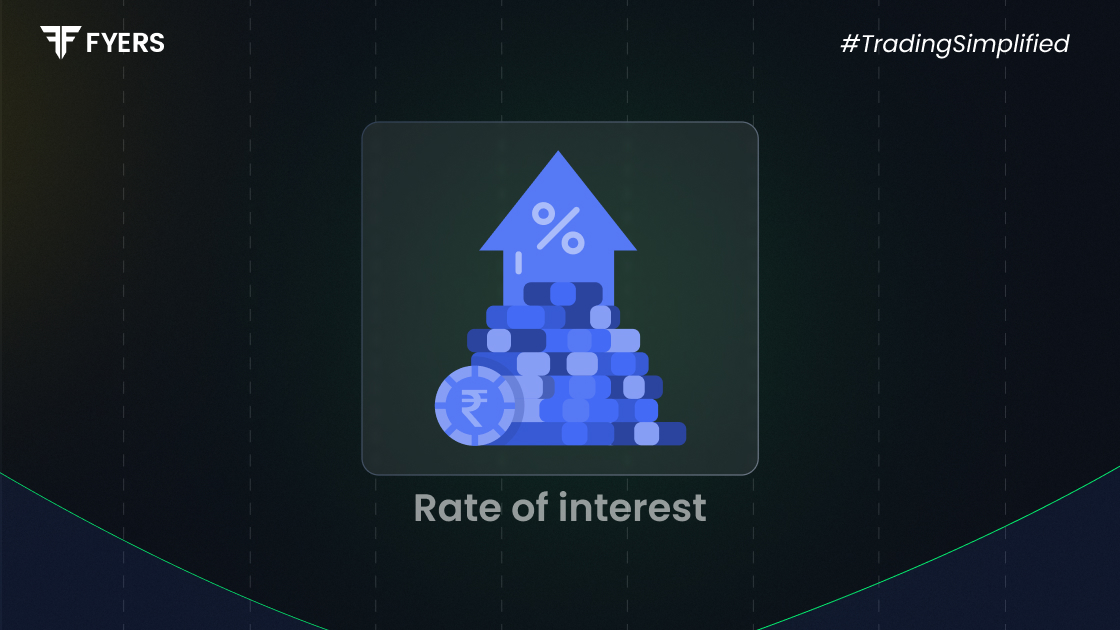

 30 Aug, 2025
30 Aug, 2025
 4 mins read
4 mins read

The interest rate quietly shapes almost every financial choice you make. From the size of your monthly mortgage payment to the return you earn on a fixed deposit, it influences both household budgets and the wider economy. Think of it as the price of money itself: how much it costs to borrow or how much you are rewarded for saving. In this guide, we will explore what interest rate is, the methods of interest rate calculation, the different types of interest rates, and why they matter so much in the Indian context.
An interest rate is the cost of borrowing money or the return earned on savings or investments. It is usually expressed as a percentage of the principal amount over a set period of time.
For borrowers, it is the price paid to use someone else’s money.
For savers and investors, it is the income earned on funds lent or deposited.
Example:
If you borrow ₹1,00,000 at a 10% annual rate of interest, you will pay ₹10,000 per year as interest.
Understanding interest rate calculation is essential for making informed borrowing and investing decisions. Interest can be calculated using two main methods: Simple Interest (SI) and Compound Interest (CI).
1. Simple Interest (SI)
Simple interest is calculated only on the original principal.
Interest Rate Formula:
|
SI = (Principal × Rate × Time) / 100 |
Example:
A ₹50,000 loan at 8% simple interest for 2 years:
SI = (50,000 × 8 × 2) / 100 = ₹8,000
2. Compound Interest (CI)
Compound interest is calculated on the principal plus any accumulated interest.
Interest Rate Formula:
CI = P × [(1 + R/100)^T – 1]
Where:
P = Principal
R = Rate of interest
T = Time in years
Example:
₹20,000 invested at 10% annually for 2 years:
CI = 20,000 × [(1 + 10/100)^2 – 1] = ₹4,200
Different financial products and market conditions give rise to different types of interest rates:
Fixed Interest Rate - Stays the same throughout the loan or investment period. Provides predictability in repayments.
Floating or Variable Interest Rate - Changes in line with benchmarks such as the RBI repo rate or MCLR. Many banks now link loans to Repo-Linked Lending Rates (RLLR). This is often compared as fixed vs. floating interest rate when choosing between stability and flexibility.
Nominal Interest Rate - The stated rate, not adjusted for inflation.
Annual Percentage Rate (APR) - Includes the base interest rate along with any additional fees or charges. Common in credit cards and consumer loans.
Real Interest Rate - Takes inflation into account to show the actual earning or cost.
|
Real Rate = Nominal Rate – Inflation Rate |
Example: If the nominal rate is 7% and inflation is 5%, the real rate is 2%.
The interest rate in India plays a crucial role in both personal finance and the national economy. It affects:
Loan and EMI affordability – Higher rates increase repayments for home, auto, and personal loans.
Savings and investment returns – Higher rates make fixed deposits, bonds, and debt mutual funds more attractive.
Inflation control – The RBI adjusts policy rates to manage inflation and economic activity.
Business and economic growth – Lower rates encourage borrowing and expansion, while higher rates may slow down spending.
Taxation and benefits – The rate of interest is also used to calculate the taxable value of concessional loans under income tax rules.
Several factors affecting interest rates in India include:
Monetary policy: The RBI sets benchmark rates such as the repo rate, reverse repo rate, and Standing Deposit Facility (SDF).
Inflation: Rising inflation usually pushes interest rates higher.
Demand and supply of credit: Strong demand for loans can push rates up.
Government borrowing: Large-scale borrowing raises bond yields and market rates.
Global trends: US Federal Reserve policy, oil prices, and currency movements also affect Indian interest rates.
Here are some examples of interest rates as of 2025 (rates vary by bank, credit score, and loan tenure):
Home loans: 8.4% to 9.5% (floating)
Personal loans: 10% to 18%
Fixed deposits (1 year): 6% to 7.5%
Savings accounts: 3% to 4%
RBI Repo Rate (policy benchmark): 6.5%
The rate of interest is more than just a figure on paper. It directly influences how much you pay on loans and how much you earn on savings. By understanding how rates are set, the methods of interest rate calculation, and the factors affecting interest rates, you can make smarter financial decisions. Keeping an eye on RBI policy moves, inflation data, and global events ensures that you are always one step ahead when it comes to borrowing or investing.
It is the cost of borrowing money or the return earned on savings, expressed as a percentage.
The RBI sets policy benchmarks like the repo rate, which banks then use to decide their lending and deposit rates.
They change due to inflation, RBI policy decisions, credit demand, and global economic conditions.
Higher rates increase EMIs and borrowing costs, while lower rates make loans more affordable.
Calculate your Net P&L after deducting all the charges like Tax, Brokerage, etc.
Find your required margin.
Calculate the average price you paid for a stock and determine your total cost.
Estimate your investment growth. Calculate potential returns on one-time investments.
Forecast your investment returns. Understand potential growth with regular contributions.